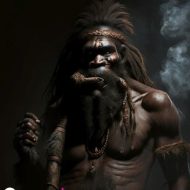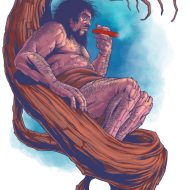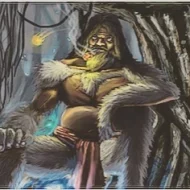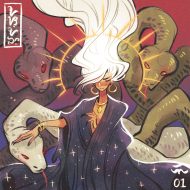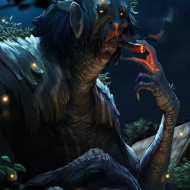Kapre : The Smelly Giant
Listen
At a glance
| Description | |
|---|---|
| Origin | Philippine Mythology |
| Classification | Hybrids |
| Family Members | N/A |
| Region | Philippines |
| Associated With | Gigantism, Strength, Invisibility |
Kapre
Introduction
The Kapre, a notable figure within Philippine mythology, is a towering giant often associated with forests and mountains. This mischievous tree-dweller, while not malevolent by nature, is known for its playful antics, particularly towards unsuspecting travelers. Its ability to manipulate surroundings adds to its enigmatic allure, drawing fascination from generations of Filipinos.
Residing amidst the diverse cultural tapestry of the Philippines, the Kapre embodies a unique blend of local beliefs and storytelling traditions. This mythical being, characterized by its towering stature, dark complexion, and dense, unkempt hair, holds a prominent place in the collective imagination of Filipino folklore.
Described as a tree demon, the Kapre is distinguished by its large frame, thick, dark hair, and an earthy aroma. The creature’s affinity for smoking tobacco, often observed with a pipe in hand, further contributes to its distinct identity. Kapres are said to favor grand trees such as acacias, mangoes, bamboo, and banyans (known locally as balete), frequently lounging beneath their colossal canopies.
Physical Traits
The Kapre, a prominent figure in Philippine folklore, is distinguished by its imposing stature, standing between 7 to 9 feet tall. This humanoid creature is characterized by a dark, hairy body emitting a distinct odor reminiscent of rotting vegetation or strong tobacco. Variations in descriptions highlight its thick, coarse hair covering the robust frame, often with a large, hairy face framed by a beard. Glowing red eyes beneath heavy brows add to the Kapre’s eerie and intimidating appearance, particularly when observed from the heights of trees where it frequently perches.
In its natural habitat of lush forests and woodlands, the Kapre’s dark skin and thick, matted hair allow it to blend seamlessly with the bark of towering trees like acacias, mangoes, banyans, and bamboo groves. Legends recount sightings of the Kapre seated high in branches, its massive form obscured by foliage as it watches passersby with a mix of curiosity and mischief. The Kapre is often depicted smoking a large pipe, the aroma of tobacco luring unsuspecting individuals closer, intrigued by the supernatural presence.
According to folklore, the Kapre may be adorned in a traditional loincloth called a “bahag,” enhancing its primal and enigmatic appearance. Some tales attribute magical abilities to the Kapre, including a belief that it possesses a belt granting invisibility, allowing the creature to vanish into the shadows of the forest at will. These enduring myths and legends surrounding the Kapre highlight its role as a guardian of the wilderness, a mysterious entity whose presence continues to captivate the imaginations of Filipinos and enthusiasts of folklore worldwide.
Family
In Philippine mythology, the Kapre is part of a mystical ecosystem that includes other forest-dwelling creatures like the tikbalang (half-human, half-horse) and nuno sa punso (dwarf-like anthill residents). These connections hint at a complex network of mythical beings within Filipino forests, each with unique roles and interactions. While specific family ties or lineage for the Kapre are not commonly detailed, it is often portrayed as a solitary creature, finding solace in the company of nature rather than other beings. Despite this solitude, tales suggest that Kapres may have loose affiliations with other forest spirits or mythological creatures, implying a broader kinship within the mystical realm.
Legends surrounding the Kapre often involve encounters with humans, sometimes even romantic entanglements. Stories depict Kapres falling in love with humans and luring them into their paradisiacal realms. In these narratives, humans are enticed by the Kapre’s offerings of food and beautiful surroundings, but there is a sinister undertone—a belief that accepting the Kapre’s offerings will result in the human’s soul being taken, leaving the body in a state of unconsciousness. Healers or “albularyos” play a role in these tales, helping to dispel the Kapre’s influence through rituals or offerings, bringing the affected human back to life.
While Kapres are often depicted as solitary beings, legends also hint at the existence of female Kapres, although details about their appearance or behavior remain scarce. Some narratives suggest a hierarchical structure among Kapres, with older and larger individuals wielding more power and influence within their mystical domain. These varied tales contribute to the enigmatic nature of the Kapre, reflecting the deep-seated beliefs and reverence for the natural world prevalent in Philippine folklore.
Other names
The term “Kapre” originates from the Arabic word “kafir,” meaning “non-believer,” which was introduced to the Philippines likely by early Arab and Moorish traders encountering indigenous populations. The Spanish, later colonizers of the archipelago, adopted this term and applied it to describe local folklore surrounding tree giants. Another name for the Kapre is “agtà,” which is also associated with the Aeta people, reflecting the rich cultural blending and linguistic influences within Philippine mythology.
In various regions of the Philippines, the Kapre is known by different names such as Agta or Agtà, signifying a forest-dwelling giant. The term “Agta,” translating to “black” in several Philippine languages, underscores the creature’s dark and mysterious appearance. These diverse names highlight the multifaceted cultural landscape of the Philippines, where myths and legends evolve with unique regional flavors and interpretations based on local traditions.
Distinct from other mythical creatures like the Tikbalang or Tianak, the Kapre is renowned for its arboreal habitat and mischievous nature. While the Tikbalang is depicted as a tall creature with horse-like features, the Tianak is specifically associated with malevolence towards children. The Kapre’s associations with Arabic roots and indigenous terms exemplify the intricate tapestry of Philippine folklore, embodying a blend of external influences and indigenous narratives that continue to shape cultural perceptions and storytelling traditions.
Powers and Abilities
The Kapre, despite its imposing demeanor, possesses a wide array of supernatural abilities deeply intertwined with its forest habitat. Foremost among these traits is its adeptness in manipulating perception, often employing illusions or mind tricks to bewilder and disorient travelers wandering through the woods. Kapres are also reputed for their mastery over natural elements, especially fire, and their knack for generating eerie sounds or echoes that resonate throughout the forest. Their immense physical strength allows them to effortlessly uproot trees and even cause seismic disturbances, showcasing their formidable prowess.
Accounts of the Kapre’s temperament vary significantly in folklore. While some portray them as mischievous tricksters who relish in confusing and frightening passersby, others depict them as potentially malevolent entities capable of stealing livestock or causing harm to humans. Yet, amidst these tales of mischief and potential danger, there are also stories of Kapres bestowing good fortune or magical items upon those who treat them with respect or make offerings. Notably, Kapres are said to dislike loud noises and foul language, with legends suggesting that individuals encountering a Kapre can deter them by creating a disturbance or throwing salt.
Belief in Kapres extends beyond the wilderness, with folklore recounting encounters where these mystical beings disrupt human homes and daily lives. Stories describe instances where individuals forget the familiarity of their own homes due to Kapre enchantment, attributing strange occurrences like rustling tree branches or mysterious voices to the presence of these supernatural beings. The glow of embers from a Kapre’s tobacco pipe is believed to explain the abundance of fireflies in wooded areas, further emphasizing the enduring influence and enigmatic nature of these forest-dwelling giants within Philippine mythology.
Modern Day Influence
The Kapre holds a significant place in Philippine folklore, recognized as a potent symbol that bridges the realms of nature and the supernatural. Its enduring presence has permeated various aspects of modern Filipino culture, influencing literature, cinema, and media. For instance, the 2015 documentary series “Creatures of Philippine Mythology” delves into the origins and evolution of the Kapre, shedding light on its role in the country’s rich cultural narrative. This exploration underscores the Kapre’s representation of the untamed wilderness, where nature commands respect and caution from human visitors.
In contemporary society, the Kapre continues to serve as more than a mere mythical entity. Its image is often employed as a cautionary symbol, reminding children to exercise prudence in unfamiliar settings. Additionally, the Kapre’s association with large trees serves as a subtle yet poignant reminder of the importance of environmental conservation, emphasizing the interconnectedness between nature and folklore. Modern Filipino literature and cinema frequently draw inspiration from the Kapre’s mischievous nature, using it as both comedic relief and a compelling narrative element in creative works.
The Kapre’s legacy extends beyond folklore, resonating deeply with Filipinos’ enduring connection to nature and the supernatural. Its influence manifests in diverse forms of artistic expression, enriching contemporary interpretations of Philippine mythology. Through its portrayal in various media forms, the Kapre preserves a sense of wonder and mystery, encapsulating the country’s cultural heritage amid the march of modernization. Thus, the Kapre’s enduring presence continues to captivate imaginations and evoke reverence for the enchanting tapestry of Philippine folklore.
Related Images
Frequently Asked Questions
What does kapre do?
The Kapre, a treetop trickster in Philippine myth, loves to mislead travelers with illusions and spooky sounds. While mischievous, they might offer good luck or get grumpy if you harm their forest home. Watch out for their immense strength and invisibility tricks!
What happens if a kapre falls in love?
A lovesick Kapre gets fixated, following their human crush endlessly. Gifts and protection might be offered, but societal disapproval and communication gaps loom large. Unrequited love can make the Kapre mischievous or even dangerous.
How to avoid kapre?
Kapres dislike noise, swearing, and disrespect for the forest. To avoid their tricks, be polite, wear your shirt inside out, or travel with a group. Strong smells like vinegar or garlic might also help keep them at bay. Be polite in the forest, say “Tabi po” to big trees.
What does a kapre smell like?
A Kapre’s stench isn’t for the faint of heart. Imagine a mix of rotting leaves and the strongest tobacco you can think of. Their giant pipes constantly pump out this pungent smoke, a way to both attract attention and clear a path. Not exactly a perfume commercial.
Is Kapre good or bad?
The Kapre are tricksters, not villains. They enjoy playful pranks, leading travelers astray. Respect the forest and you might get a lucky charm! But anger them by harming trees, and they might get grumpy. More mischievous than mean, their mood depends on you.

